October 8, 2009, Newport, California
Questions and e-Mail Interview by Bob Green
Photos Courtesy of Ron Romanosky and Cited Photographers
1. When did you first surf Wedge on a bellyboard?
The fall of 1964.
2.
How long had you been riding a bellyboard before you surfed Wedge?
What sort of bellyboard did you first surf Wedge on? Who made it?
My
first bellyboard ride was at Wedge. It was an old surfboard from which
someone had made a 4.5' long bellyboard, keeping its longboard fin. I
have no idea who did this re-do.
3. What was the attraction of bellyboards for you?
Speed
and length of ride, not to mention the ease of catching a wave,
paddling back and forth and then floating on it while waiting for waves.
4.
Given how heavy a wave Wedge is, what 'inspired' you to take a
bellyboard out that very first time, especially at Wedge? Had you
bodysurfed there much previously?
Wedge
has its days when the waves are great and won't kill you. I was a so-so
bodysurfer. I borrowed a BB from a stranger in the fall of 1964. The
waves were very good but fast that day - too fast to body. Riding that
BB that first time at Wedge ended my bodysurfing for the most part. I
occasionally bodysurf to stay in shape.
|
Wedge, September 1983. Ron on a
5'7" x 21" rounded pin tail twin fin.
Photo by Mike Moir.
|
5. Were there many bellyboarders surfing Wedge? Who were the bellyboarders who stood out?
The
bellyboarders who were there before me were Leon Montapert (I did not
ever meet Montapert) and Chuck Gardner (who I know). I heard there
was another one, reputedly a Hell's Angel named Nick who kept his
board’s aluminium skeg sharpened (I did not meet this guy either). Then
I came along. Rick Newcombe came along shortly thereafter. He and I
were good friends the summer of 1965. As far as “standing out” Gardner,
Rick and myself were about it. When I went into the Army, and then to
Vietnam, Newcombe and Gardner had Wedge and the summer of 1966 all to
themselves and the bodysurfers (there was no Blackball then). '66 was
an epic summer for good big swells. I missed that summer and most of
1967.
6. What sort of bellyboards were being ridden at Wedge? Were these
homemade boards or commercially made? What design features were needed
in a bellyboard to ride Wedge?
Every
bellyboard I saw or rode was fairly short - in the 42" to 48" long by
18” - 20" wide range I think. All had single fins during my "bellyboard
period" (1964-1968 or early 69). I don’t believe any Wedge person ever
witnessed a finless Hawaiian paipo being ridden at Wedge. We may have
talked about them, for we had heard of their use in Hawaii and maybe
even seen them in old surfing films, but we never saw one in person.
Finless BBs did not work at Wedge, as its predominantly steep and
pitching waves mandated fins (skegs) for control and stability. Without
a fin one couldn’t bottom turn a Wedge peak, stay on its wall or in its
tube. Remember that Wedge is not a sloping point break that features
lots of clean, ride-able face.
Ron with a bellyboard he was shaping, August 1967.
Estimated dimensions: 46" long x 19" to 20" wide.
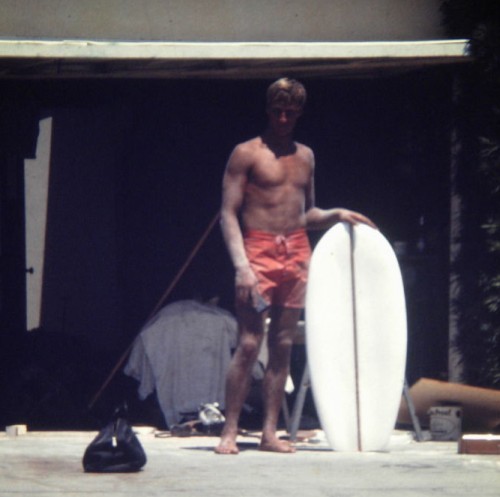
"Design features" cover just about anything one could imagine, draw up,
shape and glass. I seriously do not believe any serious hydrodynamic
testing went into any commercially built bellyboard. I think bellyboard
design relied heavily on concepts (scaled-down, squatish surfboard
shapes), that, or some design which looked like it'd work I know my
shapes were a mix of concepts and copies. If I saw one of those shapes
today I'd either laugh or cry. In the fall or winter of 1967 (could’ve
been 1964…hard to remember) I sort of copied a bellyboard made by
someone named Mouse, who had his Mouse logo on it. They were shaped
like a big arrowhead with a short rectangular "shaft" following the
wider, arrowhead-like nose - very unusual and very tough to describe.
They also had concave bottoms. I know they worked because I used them a
few times and liked the way they rode. I decided I'd try incorporating
its concave bottom into mine.
Riding the finished bellyboard at Wedge, August 1967.
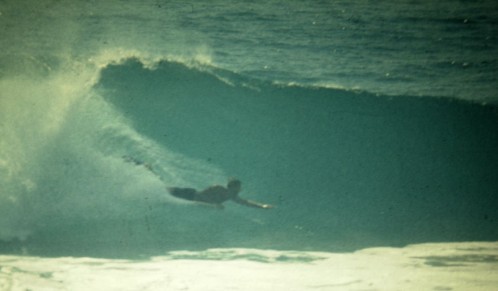
7. Who were the main manufacturers of bellyboards ridden at Wedge and surrounds?
Mouse
was perhaps the first commercial bellyboard maker, then maybe Jack's,
then came Newport Paipo. There was a Wedge model, but I think Jack's
may have had it made. These first BBs had single fins. Newport Paipo
was the first to make twin fins. Of course there may have been other
makers.
8. When was the height of bellyboards at Wedge?
1966-68 (before kneeboards) Along with belly-riding my boards I also began knee-riding them in late 1964 or early '65.
9. Can you tell me a bit about the El Paipo boards, who made them, when
they were produced, were they primarily kneeboards or bellyboards?
They
were designed to knee-ride and started showing up around 1969. Bud
Hulst was the owner who had them shaped and glassed at Petrillo’s shop
in Costa Mesa. If memory serves me right the first ones came in 48",
54", and 56" lengths. They were thin, flat and narrow, maybe 19" wide.
"Customs" for Hulst's riders were 58" to 60" long.
10.
Neither the history of bellyboards nor kneeboards is well documented.
What prompted you to try kneeriding? Was this first on a bellyboard or
a kneeboard?
Bellyboarding
was fun in the beginning, but as time wore on I found that I wanted do
more on a board than merely belly-ride them. When bellyboarding these
short boards part of my body always seemed to be in the water. That
created a lot of drag. Plus it was just so easy. I decided to try knee
riding my bellyboards and found that I could, being the first to do so
at Wedge. Knee riding a bellyboard required more skill and I liked the
challenge. My friends were stoked with my knee riding. Naturally, I
aimed to please. It got to be that I'd knee ride any wave I could
rather than belly ride it, unless it was big. I learned early on that
knee riding a short bellyboard on big Wedge waves was practically
impossible… their inadequate designs made free-falls and wipe-outs
certainties. But I continued making-do with what I had to ride, not
having the money to experiment with other shapes and glassing.
Sometime during one summer I saw George Greenough's kneeboarding in The
Endless Summer (I forget the year). That inspired me to concentrate
mostly on kneeboarding. I stopped bellyboarding completely by the
spring of 1969. My first kneeboard was a scaled down pintail surfboard
built and given me by Russell Surfboards. It was "designed" to both
bellyboard and knee ride, maybe 54" long by maybe 19" wide (by today's
standards it was not a kneeboard by any stretch of the imagination). In
September 1969 I was riding El Paipo kneeboards and working for its
owner, Bud Hulst. Still, these kneeboards left much to be desired. Time
would correct all the initial shortcomings of the first commercial
kneeboards - great innovation and improvement lay ahead.
Wedge, 1970. Ron bottom turning on a 5' flex spoon. It was maybe 20.5" to 21" wide.
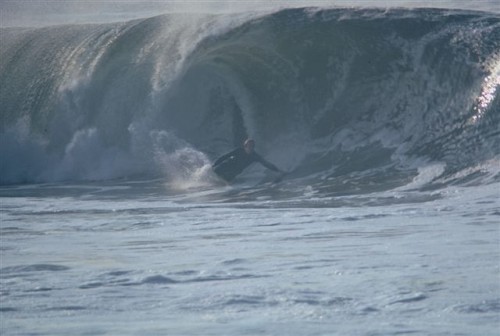
Photo by John Ramuno.
11. How did the experience of wave-riding a bellyboard and a kneeboard
differ? Was there a period you rode both styles, or were you 'hooked'
once you first started kneeriding?
After
getting better at kneeboarding there was no longer any attraction to
bellyboarding. Kneeboarding (that is - on boards designed to knee ride)
meant bigger waves, more maneuvers and more speed. It required a lot
more skill, and the great attraction was that one got more skilled
quickly if he put the time in. Being on a board which allowed you to be
above and in control of it and the wave just felt better. And becoming
more skilled meant getting more tube rides with these boards. I think
most individuals who got into kneeboarding at its beginning (1969 -
1972) felt this also. Plus, wearing fins allowed one to catch big and
steep waves. And if you lost your board you could swim in quickly to
get it. (There were no leashes at this time.)
Wedge, 1986. Ron on a rounded diamond tail tri-fin, 5' 7" x 21.5".
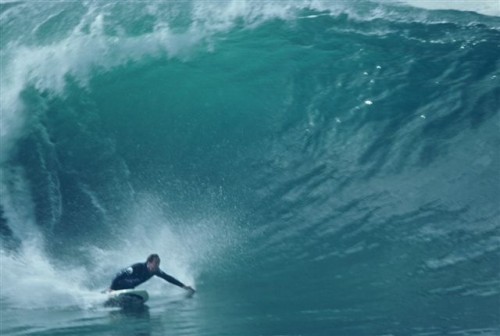
Photo by Joel Mayer.
12. Do you still see wood or fibreglass bellyboards ridden at Wedge or around the coast where you surf?
No. The last time I saw a BB at Wedge was in 1996.
13. Any other comments about bellyboarding, its history or connection to kneeboards?
Bellyboarding
is essentially dead in these parts except to those who collect them.
The bellyboarder of this era is the booger/sponger, and there are
hundreds of thousands of such. For them a whole industry is in place
committed to popping out the things which makes it possible for anyone
- at any age, in virtually any physical condition, from any state in
the country - to ride a wave or whitewater their first day in the
ocean. Kneeboarding, from all the current indications - and sad to say
– will be practiced less and less as time goes on, especially in the
U.S. No new blood infuses this way of surfing, its popularity having
peaked in the late 1970’s to mid 80’s. The upside: like bellyboards,
kneeboards and spoons of the 60's and 70's are collectible.
Wedge, May 24, 1999. Ron riding on a rounded pin tail quad (my favorite design and of those who ride my boards). The board
measurements: 5'7" x 22.25" x 2.4".
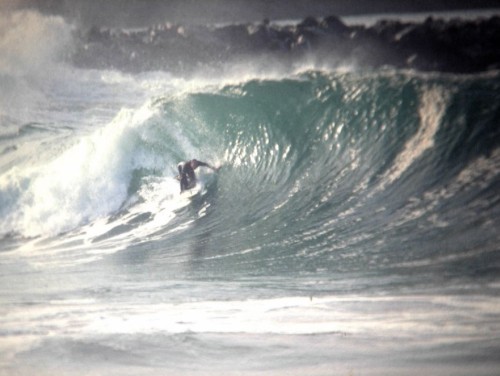
Photo by Dennis Junor.
|
Ron Romanosky's Web Sites, Romanosky Kneeboards and Romanosky Photo.
|
|